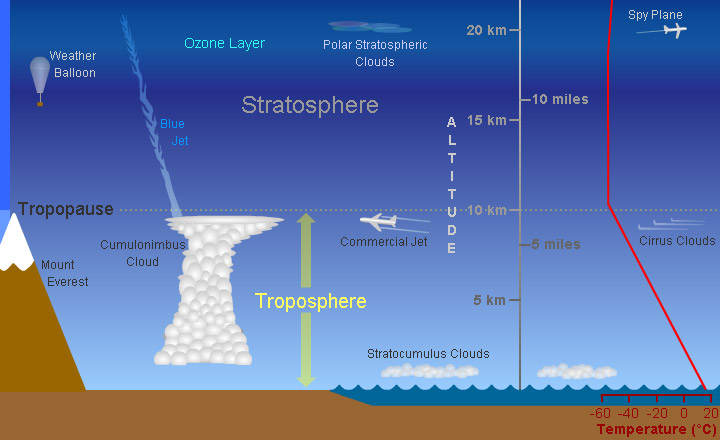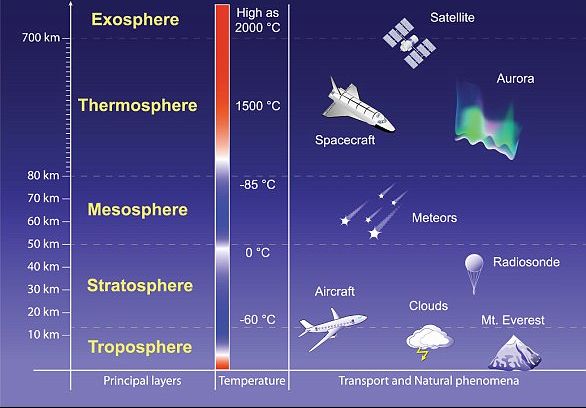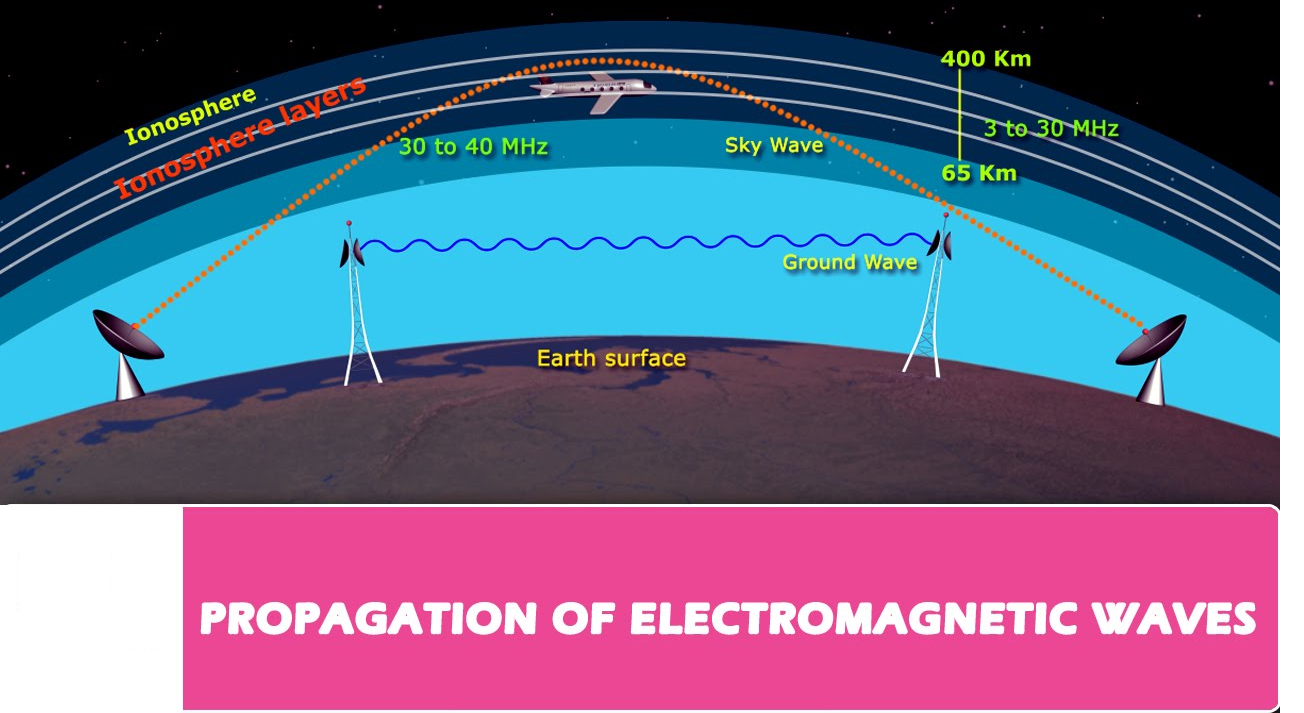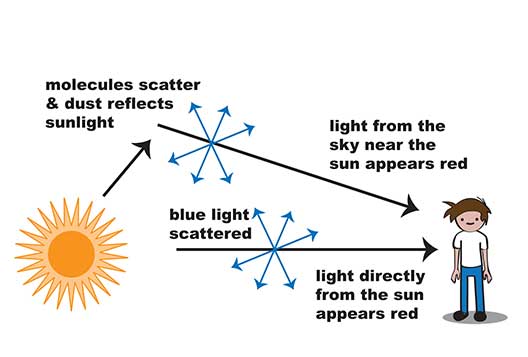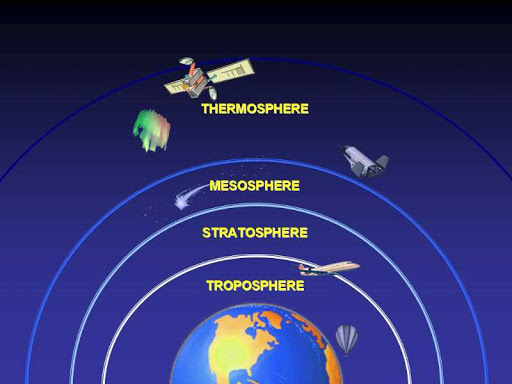The Jan 25th Static Quiz on Geography (Atmosphere Structure and Composition, Temperature)
Quiz-summary
0 of 10 questions completed
Questions:
- 1
- 2
- 3
- 4
- 5
- 6
- 7
- 8
- 9
- 10
Information
The Jan 25th Static Quiz on Geography (Atmosphere Structure and Composition, Temperature)
You have already completed the quiz before. Hence you can not start it again.
Quiz is loading...
You must sign in or sign up to start the quiz.
You have to finish following quiz, to start this quiz:
Results
0 of 10 questions answered correctly
Your time:
Time has elapsed
You have reached 0 of 0 points, (0)
Categories
- Not categorized 0%
- 1
- 2
- 3
- 4
- 5
- 6
- 7
- 8
- 9
- 10
- Answered
- Review
- Question 1 of 10
1. Question
Which of the following statements are correct about the earth’s atmosphere?
1. The atmosphere layer closest to the earth is referred to as the troposphere.
2. Our planet earth is enveloped by a deep blanket of gases extending several thousands of kilometres above its surface.
3. In the absence of the atmosphere extremes of temperature would exist between day and night over the earth’s surface.CorrectAns;- d) All of the above
Explanation;-
• All the statements are correct.
About Earth’s Atmosphere
• Earth’s atmosphere is composed of about 78 percent nitrogen, 21 percent oxygen, 0.9 percent argon, and 0.1 percent other gases. Trace amounts of carbon dioxide, methane, water vapor, and neon are some of the other gases that make up the remaining 0.1 percent.
• Earth’s atmosphere is composed of about 78 percent nitrogen, 21 percent oxygen, 0.9 percent argon, and 0.1 percent other gases. Trace amounts of carbon dioxide, methane, water vapor, and neon are some of the other gases that make up the remaining 0.1 percent.
• Earth’s atmosphere is composed of about 78 percent nitrogen, 21 percent oxygen, 0.9 percent argon, and 0.1 percent other gases. Trace amounts of carbon dioxide, methane, water vapor, and neon are some of the other gases that make up the remaining 0.1 percent.
• The atmosphere protects living things from the Sun’s most harmful rays. Gases reflect or absorb the strongest rays of sunlight .
• The atmosphere shields Earth from the most harmful solar rays.Role of Earth’s Atmosphere
• The atmosphere contains various gases like oxygen, carbon dioxide, nitrogen etc.
• Plants require carbon dioxide to survive while animals and many other organisms need oxygen for their survival.
• The atmosphere supplies these life giving gases.
• All life forms need a particular range of temperature and a specific range of frequencies of solar radiation to carry out their biophysical processes.
• The atmosphere absorbs certain frequencies and lets through some other frequencies of solar radiation. In other words, the atmosphere regulates the entry of solar radiation.
• The atmosphere also keeps the temperature over the earth’s surface within certain limits. In the absence of the atmosphere extremes of temperature would exist between day and night over the earth’s surface.
• Harmful ultraviolet radiation would find its way through, if the atmosphere (ozone in stratosphere to be specific) were absent.
• The atmosphere also takes care of extra-terrestrial objects like meteors which get burnt up while passing through the atmosphere (mesosphere to be precise) due to friction.
• Weather is another important phenomenon which dictates the direction of a number of natural and man-made processes like plant growth, agriculture, soil-formation, human settlements, etc. Various climatic factors join together to create weather.IncorrectAns;- d) All of the above
Explanation;-
• All the statements are correct.
About Earth’s Atmosphere
• Earth’s atmosphere is composed of about 78 percent nitrogen, 21 percent oxygen, 0.9 percent argon, and 0.1 percent other gases. Trace amounts of carbon dioxide, methane, water vapor, and neon are some of the other gases that make up the remaining 0.1 percent.
• Earth’s atmosphere is composed of about 78 percent nitrogen, 21 percent oxygen, 0.9 percent argon, and 0.1 percent other gases. Trace amounts of carbon dioxide, methane, water vapor, and neon are some of the other gases that make up the remaining 0.1 percent.
• Earth’s atmosphere is composed of about 78 percent nitrogen, 21 percent oxygen, 0.9 percent argon, and 0.1 percent other gases. Trace amounts of carbon dioxide, methane, water vapor, and neon are some of the other gases that make up the remaining 0.1 percent.
• The atmosphere protects living things from the Sun’s most harmful rays. Gases reflect or absorb the strongest rays of sunlight .
• The atmosphere shields Earth from the most harmful solar rays.Role of Earth’s Atmosphere
• The atmosphere contains various gases like oxygen, carbon dioxide, nitrogen etc.
• Plants require carbon dioxide to survive while animals and many other organisms need oxygen for their survival.
• The atmosphere supplies these life giving gases.
• All life forms need a particular range of temperature and a specific range of frequencies of solar radiation to carry out their biophysical processes.
• The atmosphere absorbs certain frequencies and lets through some other frequencies of solar radiation. In other words, the atmosphere regulates the entry of solar radiation.
• The atmosphere also keeps the temperature over the earth’s surface within certain limits. In the absence of the atmosphere extremes of temperature would exist between day and night over the earth’s surface.
• Harmful ultraviolet radiation would find its way through, if the atmosphere (ozone in stratosphere to be specific) were absent.
• The atmosphere also takes care of extra-terrestrial objects like meteors which get burnt up while passing through the atmosphere (mesosphere to be precise) due to friction.
• Weather is another important phenomenon which dictates the direction of a number of natural and man-made processes like plant growth, agriculture, soil-formation, human settlements, etc. Various climatic factors join together to create weather. - Question 2 of 10
2. Question
Which of the following statements about Composition of Atmosphere are correct?
1. The earth atmosphere it contains huge numbers of solid and liquid particles, collectively called ‘aerosols’.
2. The proportion of gases changes in the higher layers of the atmosphere in such a way that oxygen will be almost in negligible quantity
3. Some of the gases may be regarded as permanent atmospheric components which remain in fixed proportion to the total gas volume.CorrectAns;- d) All of the above
Explanation;-
• All the statements are correct
About Composition of Atmosphere
• The atmosphere is a mixture of many gases. In addition, it contains huge numbers of solid and liquid particles, collectively called ‘aerosols’.
• Some of the gases may be regarded as permanent atmospheric components which remain in fixed proportion to the total gas volume.
• Other constituents vary in quantity from place to place and from time to time. If the suspended particles, water vapour and other variable gases were excluded from the atmosphere, then the dry air is very stable all over the earth up to an altitude of about 80 kilometres.
• The proportion of gases changes in the higher layers of the atmosphere in such a way that oxygen will be almost in negligible quantity at the height of 120 km. Similarly, carbon dioxide and water vapour are found only up to 90 km from the surface of the earth.
• Nitrogen and oxygen make up nearly 99% of the clean, dry air. The remaining gases are mostly inert and constitute about 1% of the atmosphere.
• Besides these gases, large quantities of water vapour and dust particles are also present in the atmosphere. These solid and liquid particles are of great climatic significance.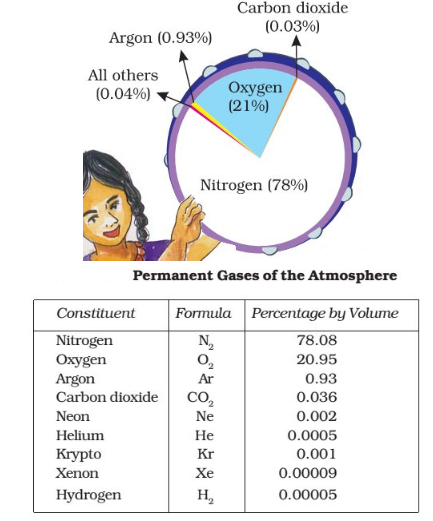 Incorrect
IncorrectAns;- d) All of the above
Explanation;-
• All the statements are correct
About Composition of Atmosphere
• The atmosphere is a mixture of many gases. In addition, it contains huge numbers of solid and liquid particles, collectively called ‘aerosols’.
• Some of the gases may be regarded as permanent atmospheric components which remain in fixed proportion to the total gas volume.
• Other constituents vary in quantity from place to place and from time to time. If the suspended particles, water vapour and other variable gases were excluded from the atmosphere, then the dry air is very stable all over the earth up to an altitude of about 80 kilometres.
• The proportion of gases changes in the higher layers of the atmosphere in such a way that oxygen will be almost in negligible quantity at the height of 120 km. Similarly, carbon dioxide and water vapour are found only up to 90 km from the surface of the earth.
• Nitrogen and oxygen make up nearly 99% of the clean, dry air. The remaining gases are mostly inert and constitute about 1% of the atmosphere.
• Besides these gases, large quantities of water vapour and dust particles are also present in the atmosphere. These solid and liquid particles are of great climatic significance.
- Question 3 of 10
3. Question
Which of the following statements about Troposphere are correct?
1. It is the atmospheric layer between the earth’s surface and an altitude of 8 km at the equator and 18 km at the poles.
2. The troposphere ends with the Tropopause.
3. The troposphere is marked by temperature inversion, turbulence and eddies.CorrectAns;- b) Only 2 and 3
Explanation;-
• The 1st statemnet is incorrect because at poles is 8km and 18km at the Equator
About Troposphere
• It is the atmospheric layer between the earth’s surface and an altitude of 8 km at the poles and 18 km at the equator.
• The thickness is greater at the equator, because the heated air rises to greater heights.
• The troposphere ends with the Tropopause.
• The temperature in this layer, as one goes upwards, falls at the rate of 5°C per kilometer, and reaches -45°C at the poles and -80°C over the equator at Tropopause (greater fall in temperature above equator is because of the greater thickness of troposphere – 18 km).
• The fall in temperature is called ‘lapse rate’.
• The troposphere is marked by temperature inversion, turbulence and eddies.
• It is also meteorologically the most significant zone in the entire atmosphere (Almost all the weather phenomena like rainfall, fog and hailstorm etc. are confined to this layer).
• It is also called the convective region, since all convection stops at Tropopause.
• The troposphere is the theatre for weather because all cyclones, anticyclones, storms and precipitation occur here, as all water vapors and solid particles lie within this.
• The troposphere is influenced by seasons and jet streams. Incorrect
IncorrectAns;- b) Only 2 and 3
Explanation;-
• The 1st statemnet is incorrect because at poles is 8km and 18km at the Equator
About Troposphere
• It is the atmospheric layer between the earth’s surface and an altitude of 8 km at the poles and 18 km at the equator.
• The thickness is greater at the equator, because the heated air rises to greater heights.
• The troposphere ends with the Tropopause.
• The temperature in this layer, as one goes upwards, falls at the rate of 5°C per kilometer, and reaches -45°C at the poles and -80°C over the equator at Tropopause (greater fall in temperature above equator is because of the greater thickness of troposphere – 18 km).
• The fall in temperature is called ‘lapse rate’.
• The troposphere is marked by temperature inversion, turbulence and eddies.
• It is also meteorologically the most significant zone in the entire atmosphere (Almost all the weather phenomena like rainfall, fog and hailstorm etc. are confined to this layer).
• It is also called the convective region, since all convection stops at Tropopause.
• The troposphere is the theatre for weather because all cyclones, anticyclones, storms and precipitation occur here, as all water vapors and solid particles lie within this.
• The troposphere is influenced by seasons and jet streams.
- Question 4 of 10
4. Question
Which of the following statemnets about Stratosphere are correct?
1. It lies beyond troposphere, up to an altitude of 50 km from the earth’s surface.
2. This layer is almost free from clouds and associated weather phenomenon, making conditions most ideal for flying aero planes.CorrectAns;- c) Both 1 and 2
Explanation;-
• Both the statements are correct about Stratosphere
About Stratosphere
• The stratosphere is the second major layer of Earth’s atmosphere, just above the troposphere, and below the mesosphere.
• It lies beyond troposphere, up to an altitude of 50 km from the earth’s surface.
• The temperature in this layer remains constant for some distance but then rises to reach a level of 0°C at 50 km altitude.
• This rise is due to the presence of ozone (harmful ultraviolet radiation is absorbed by ozone).
• This layer is almost free from clouds and associated weather phenomenon, making conditions most ideal for flying aero planes.
• So aeroplanes fly in lower stratosphere, sometimes in upper troposphere where weather is calm.
• Sometimes, cirrus clouds are present at lower levels in this layer. Incorrect
IncorrectAns;- c) Both 1 and 2
Explanation;-
• Both the statements are correct about Stratosphere
About Stratosphere
• The stratosphere is the second major layer of Earth’s atmosphere, just above the troposphere, and below the mesosphere.
• It lies beyond troposphere, up to an altitude of 50 km from the earth’s surface.
• The temperature in this layer remains constant for some distance but then rises to reach a level of 0°C at 50 km altitude.
• This rise is due to the presence of ozone (harmful ultraviolet radiation is absorbed by ozone).
• This layer is almost free from clouds and associated weather phenomenon, making conditions most ideal for flying aero planes.
• So aeroplanes fly in lower stratosphere, sometimes in upper troposphere where weather is calm.
• Sometimes, cirrus clouds are present at lower levels in this layer.
- Question 5 of 10
5. Question
Atmospheric layer which reflects radio waves are called?
CorrectAns;- b) Ionosphere
Explanation;-
• The layer of the atmosphere that reflects radio waves is the ionosphere.
• That is because there are gas particles in the ionosphere that are ionized, or that carry an electrical charge.
• The ionosphere is a layer which includes the thermosphere and part of the mesosphere and exosphere. Incorrect
IncorrectAns;- b) Ionosphere
Explanation;-
• The layer of the atmosphere that reflects radio waves is the ionosphere.
• That is because there are gas particles in the ionosphere that are ionized, or that carry an electrical charge.
• The ionosphere is a layer which includes the thermosphere and part of the mesosphere and exosphere.
- Question 6 of 10
6. Question
The sky looks blue because of which of the folllowing reasons?
CorrectAns;- b) Selective scattering of radiation by atmosphere
Explanation;-
• Gases and particles in Earth’s atmosphere scatter sunlight in all directions. Blue light is scattered more than other colors because it travels as shorter, smaller waves. This is why we see a blue sky most of the time.
• A day-time sky is blue because molecules in the air scatter blue light from the sun more than they scatter red light. When we look towards the sun at sunset, we see red and orange colors because the blue light has been scattered out and away from the line of sight. Incorrect
IncorrectAns;- b) Selective scattering of radiation by atmosphere
Explanation;-
• Gases and particles in Earth’s atmosphere scatter sunlight in all directions. Blue light is scattered more than other colors because it travels as shorter, smaller waves. This is why we see a blue sky most of the time.
• A day-time sky is blue because molecules in the air scatter blue light from the sun more than they scatter red light. When we look towards the sun at sunset, we see red and orange colors because the blue light has been scattered out and away from the line of sight.
- Question 7 of 10
7. Question
Normally the temperature decreases with the increase in height from the earth’s surface because
1. The atmosphere can be heated upwards only from the earth’s surface
2. There is more moisture in the upper atmosphere
3. The air is less dense in the upper atmosphereCorrectAns;- c) Only 1 and 3
Explanation;-
• The temperature decreases with height in the lowest 10-20 km of the atmosphere (called the troposphere) because most of the solar radiation passes through the atmosphere with little or no effect that radiation is absorbed by the solid earth surface and is transferred to the air above the surface by conduction.
IncorrectAns;- c) Only 1 and 3
Explanation;-
• The temperature decreases with height in the lowest 10-20 km of the atmosphere (called the troposphere) because most of the solar radiation passes through the atmosphere with little or no effect that radiation is absorbed by the solid earth surface and is transferred to the air above the surface by conduction.
- Question 8 of 10
8. Question
Match the following lists
List-1 List-2
A. Temperature Falls with height 1. Ionosphere
B. Reflects radio waves back to earth 2. Stratosphere
C. Contains most of the ozone 3. Tropopause
D. Fall in temperature slops 4. TroposphereCorrectAns;- c) A-4,B-1,C-2,D-3
Explanation;-
• The atmosphere is comprised of layers based on temperature. These layers are the troposphere, stratosphere, mesosphere and thermosphere. A further region at about 500 km above the Earth’s surface is called the exosphere.
• The different layers of the atmosphere
• The atmosphere can be divided into layers based on its temperature, as shown in the figure below. These layers are the troposphere, the stratosphere, the mesosphere and the thermosphere. A further region, beginning about 500 km above the Earth’s surface, is called the exosphere.
• The red line on the figure below shows how temperature varies with height (the temperature scale is given along the bottom of the diagram). The scale on the right shows the pressure. For example, at a height of 50 km, the pressure is only about one thousandth of the pressure at the ground.The Troposphere
• This is the lowest part of the atmosphere – the part we live in. It contains most of our weather – clouds, rain, snow. In this part of the atmosphere the temperature gets colder as the distance above the earth increases, by about 6.5°C per kilometre. The actual change of temperature with height varies from day to day, depending on the weather.
• The troposphere contains about 75% of all of the air in the atmosphere, and almost all of the water vapour (which forms clouds and rain). The decrease in temperature with height is a result of the decreasing pressure. If a parcel of air moves upwards it expands (because of the lower pressure). When air expands it cools. So air higher up is cooler than air lower down.
• The lowest part of the troposphere is called the boundary layer. This is where the air motion is determined by the properties of the Earth’s surface. Turbulence is generated as the wind blows over the Earth’s surface, and by thermals rising from the land as it is heated by the sun. This turbulence redistributes heat and moisture within the boundary layer, as well as pollutants and other constituents of the atmosphere.
• The top of the troposphere is called the tropopause. This is lowest at the poles, where it is about 7 – 10 km above the Earth’s surface. It is highest (about 17 – 18 km) near the equator.The Stratosphere
• This extends upwards from the tropopause to about 50 km. It contains much of the ozone in the atmosphere. The increase in temperature with height occurs because of absorption of ultraviolet (UV) radiation from the sun by this ozone. Temperatures in the stratosphere are highest over the summer pole, and lowest over the winter pole.
• By absorbing dangerous UV radiation, the ozone in the stratosphere protects us from skin cancer and other health damage. However chemicals (called CFCs or freons, and halons) which were once used in refrigerators, spray cans and fire extinguishers have reduced the amount of ozone in the stratosphere, particularly at polar latitudes, leading to the so-called “Antarctic ozone hole”.
• Now humans have stopped making most of the harmful CFCs we expect the ozone hole will eventually recover over the 21st century, but this is a slow process.The Mesosphere
• The region above the stratosphere is called the mesosphere. Here the temperature again decreases with height, reaching a minimum of about -90°C at the “mesopause”.
The Thermosphere and Ionosphere
• The thermosphere lies above the mesopause, and is a region in which temperatures again increase with height. This temperature increase is caused by the absorption of energetic ultraviolet and X-Ray radiation from the sun.
• The region of the atmosphere above about 80 km is also caused the “ionosphere”, since the energetic solar radiation knocks electrons off molecules and atoms, turning them into “ions” with a positive charge. The temperature of the thermosphere varies between night and day and between the seasons, as do the numbers of ions and electrons which are present. The ionosphere reflects and absorbs radio waves, allowing us to receive shortwave radio broadcasts in New Zealand from other parts of the world.The Exosphere
• The region above about 500 km is called the exosphere. It contains mainly oxygen and hydrogen atoms, but there are so few of them that they rarely collide – they follow “ballistic” trajectories under the influence of gravity, and some of them escape right out into space.
The Magnetosphere
• The earth behaves like a huge magnet. It traps electrons (negative charge) and protons (positive), concentrating them in two bands about 3,000 and 16,000 km above the globe – the Van Allen “radiation” belts. This outer region surrounding the earth, where charged particles spiral along the magnetic field lines, is called the magnetosphere.
 Incorrect
IncorrectAns;- c) A-4,B-1,C-2,D-3
Explanation;-
• The atmosphere is comprised of layers based on temperature. These layers are the troposphere, stratosphere, mesosphere and thermosphere. A further region at about 500 km above the Earth’s surface is called the exosphere.
• The different layers of the atmosphere
• The atmosphere can be divided into layers based on its temperature, as shown in the figure below. These layers are the troposphere, the stratosphere, the mesosphere and the thermosphere. A further region, beginning about 500 km above the Earth’s surface, is called the exosphere.
• The red line on the figure below shows how temperature varies with height (the temperature scale is given along the bottom of the diagram). The scale on the right shows the pressure. For example, at a height of 50 km, the pressure is only about one thousandth of the pressure at the ground.The Troposphere
• This is the lowest part of the atmosphere – the part we live in. It contains most of our weather – clouds, rain, snow. In this part of the atmosphere the temperature gets colder as the distance above the earth increases, by about 6.5°C per kilometre. The actual change of temperature with height varies from day to day, depending on the weather.
• The troposphere contains about 75% of all of the air in the atmosphere, and almost all of the water vapour (which forms clouds and rain). The decrease in temperature with height is a result of the decreasing pressure. If a parcel of air moves upwards it expands (because of the lower pressure). When air expands it cools. So air higher up is cooler than air lower down.
• The lowest part of the troposphere is called the boundary layer. This is where the air motion is determined by the properties of the Earth’s surface. Turbulence is generated as the wind blows over the Earth’s surface, and by thermals rising from the land as it is heated by the sun. This turbulence redistributes heat and moisture within the boundary layer, as well as pollutants and other constituents of the atmosphere.
• The top of the troposphere is called the tropopause. This is lowest at the poles, where it is about 7 – 10 km above the Earth’s surface. It is highest (about 17 – 18 km) near the equator.The Stratosphere
• This extends upwards from the tropopause to about 50 km. It contains much of the ozone in the atmosphere. The increase in temperature with height occurs because of absorption of ultraviolet (UV) radiation from the sun by this ozone. Temperatures in the stratosphere are highest over the summer pole, and lowest over the winter pole.
• By absorbing dangerous UV radiation, the ozone in the stratosphere protects us from skin cancer and other health damage. However chemicals (called CFCs or freons, and halons) which were once used in refrigerators, spray cans and fire extinguishers have reduced the amount of ozone in the stratosphere, particularly at polar latitudes, leading to the so-called “Antarctic ozone hole”.
• Now humans have stopped making most of the harmful CFCs we expect the ozone hole will eventually recover over the 21st century, but this is a slow process.The Mesosphere
• The region above the stratosphere is called the mesosphere. Here the temperature again decreases with height, reaching a minimum of about -90°C at the “mesopause”.
The Thermosphere and Ionosphere
• The thermosphere lies above the mesopause, and is a region in which temperatures again increase with height. This temperature increase is caused by the absorption of energetic ultraviolet and X-Ray radiation from the sun.
• The region of the atmosphere above about 80 km is also caused the “ionosphere”, since the energetic solar radiation knocks electrons off molecules and atoms, turning them into “ions” with a positive charge. The temperature of the thermosphere varies between night and day and between the seasons, as do the numbers of ions and electrons which are present. The ionosphere reflects and absorbs radio waves, allowing us to receive shortwave radio broadcasts in New Zealand from other parts of the world.The Exosphere
• The region above about 500 km is called the exosphere. It contains mainly oxygen and hydrogen atoms, but there are so few of them that they rarely collide – they follow “ballistic” trajectories under the influence of gravity, and some of them escape right out into space.
The Magnetosphere
• The earth behaves like a huge magnet. It traps electrons (negative charge) and protons (positive), concentrating them in two bands about 3,000 and 16,000 km above the globe – the Van Allen “radiation” belts. This outer region surrounding the earth, where charged particles spiral along the magnetic field lines, is called the magnetosphere.

- Question 9 of 10
9. Question
Consider the following statements are correct?
1. Normally temperature decreases with increase in elevation, called as normal Lapse rate
2. A long winter night with clear skies and still air can have Inversion of temperature i.e. temperature increases with increase in the height
3. Over polar areas temperature inversion is normal throughout the yearCorrectAns;- d) All of the above
Explanation;-
• All the statements are correct.
IncorrectAns;- d) All of the above
Explanation;-
• All the statements are correct.
- Question 10 of 10
10. Question
Ans;- d) All of the above
Explanation;-
• All the statements are correct.
Which of the following factors can influence the temperature of a place?
1. latitude of the place
2. altitude of the place
3. distance from the sea
4. air-mass circulationCorrectAns;- d) All of the above
Explanation;-
About Factors Affecting Temperature Distribution
• The temperature of air at every place is influenced by :-
a) The latitude of the place
b) The altitude of the place
c) Distance from the sea
d) The air- mass circulation
e) The presence of warm and cold ocean currents
f) Local aspectsIncorrectAns;- d) All of the above
Explanation;-
About Factors Affecting Temperature Distribution
• The temperature of air at every place is influenced by :-
a) The latitude of the place
b) The altitude of the place
c) Distance from the sea
d) The air- mass circulation
e) The presence of warm and cold ocean currents
f) Local aspects

